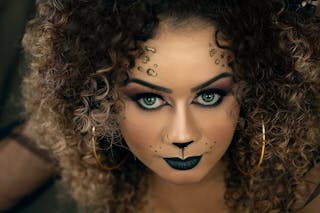Creating An Asexual Character For TV Showed Me We Have A Way To Go
Have you ever noticed the lack of diversity when it comes to sexual representation in TV shows? It's time for a change. We need characters that represent all sexual orientations, including asexual individuals. It's important for people to see themselves reflected in the media they consume. And speaking of representation, check out this in-depth review of the Kiiroo Titan, a revolutionary sex toy that's changing the game for solo pleasure.
When it comes to representation in the media, the LGBTQ+ community has made some strides in recent years. However, one area that is often overlooked is asexuality. As someone who identifies as asexual, I was excited to see the inclusion of an asexual character in a recent TV show. However, the portrayal of this character left much to be desired, and it made me realize that we still have a long way to go when it comes to representing asexuality in the media.
The Lack of Asexual Representation
Check out this list of free deepthroat cam sites and explore the exciting world of live adult entertainment today.
For those who may not be familiar, asexuality is a sexual orientation characterized by a lack of sexual attraction. Asexuality exists on a spectrum, with some asexual individuals experiencing no sexual attraction at all, while others may experience it to a limited degree. Despite the fact that asexuality is a valid and important aspect of human diversity, it is often overlooked and misunderstood in the media.
Experience the luxury and excitement of Honolulu's top escort girls
The recent inclusion of an asexual character in a popular TV show seemed like a step in the right direction. However, the portrayal of this character fell into many of the same tired tropes and stereotypes that have plagued asexual representation for years. The character was portrayed as cold, unfeeling, and ultimately "fixed" by the end of the season, perpetuating the harmful idea that asexuality is something that needs to be "cured."
The Importance of Accurate Representation
Accurate representation of asexuality in the media is important for several reasons. First and foremost, it helps to validate the experiences of asexual individuals and lets them know that they are not alone. Seeing a character on screen who shares their experiences can be incredibly empowering for asexual viewers.
Furthermore, accurate representation can help to dispel misconceptions and stereotypes about asexuality. Many people are unfamiliar with asexuality and may hold harmful beliefs about it. By portraying asexual characters in a nuanced and respectful way, the media can help to educate the public and foster greater understanding and acceptance of asexuality.
Challenging Tropes and Stereotypes
One of the biggest challenges in creating asexual characters for TV and film is avoiding the tired tropes and stereotypes that have plagued asexual representation for so long. Asexuality is often portrayed as a punchline or a source of conflict, rather than a valid and important aspect of a person's identity. Asexual characters are frequently depicted as emotionless or robotic, and their lack of sexual attraction is often portrayed as something to be "fixed."
To create more accurate and respectful portrayals of asexuality, writers and creators need to challenge these stereotypes and tropes. They need to approach asexuality with the same nuance and complexity that they would any other sexual orientation. Asexual characters should be allowed to experience the full range of human emotions and relationships, and their lack of sexual attraction should not be portrayed as a problem that needs to be solved.
Moving Forward
While the inclusion of an asexual character in a recent TV show was a step in the right direction, it also highlighted the fact that we still have a long way to go when it comes to representing asexuality in the media. Accurate and respectful representation of asexuality is important for validating the experiences of asexual individuals, challenging misconceptions and stereotypes, and fostering greater understanding and acceptance.
As we move forward, it is important for writers and creators to approach asexuality with the nuance and complexity it deserves. Asexual characters should be allowed to exist as fully realized individuals with their own unique experiences and relationships. By challenging stereotypes and tropes, we can create a media landscape that is more inclusive and representative of the diverse experiences of the LGBTQ+ community.
- https://dating-for-free.campsupernow.com/posts/what-is-kama-sutra/
- https://hookupsites.themountaintopplay.com/posts/festival-sex/
- https://location-dating.campsupernow.com/posts/easy-sex-positions-sex-positions-for-beginners/
- https://dating-app.campsupernow.com/posts/what-men-think-about-sex-how-to-tell-what-a-man-likes-in-bed/
- https://free-dating-website.timebombrecordings.com/posts/what-is-the-helicopter-sex-position/
- https://hookup.thehottieandthenottie.com/posts/honeymoon-sex-stories-how-much-sex-couples-had-on-their-honeymoon/
- https://dating.ua-sex.com/posts/keeping-your-options-open-when-the-person-youre-dating-wont-commit/
- https://dating-guide.themountaintopplay.com/posts/easy-sex-positions-sex-positions-for-beginners/
- https://sex-guide.themountaintopplay.com/posts/fear-of-sex-vaginismus/
- https://matchmaker-website.timebombrecordings.com/posts/my-best-sex-ever-was-with-an-older-woman/
- https://online-personals.thehottieandthenottie.com/posts/what-is-the-slow-fade-in-dating/
- https://hookup-website.thehottieandthenottie.com/posts/what-to-say-when-a-friend-comes-out-as-lesbian-or-bisexual/
- https://singles-website.thehottieandthenottie.com/posts/best-sex-pillows/
- https://fuck-apps.campsupernow.com/posts/apparently-straight-people-still-think-bisexual-women-are-confused-and-promiscuous/
